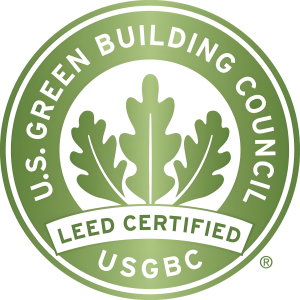The embodied carbon of building materials contributes to 13% of all global greenhouse gas emissions. To address this impact, the LEED rating system has established several credits that encourage projects to purchase materials with beneficial life cycle impacts and low embodied carbon that also promote building inhabitants’ safety, heath and well-being. Continuing to develop more holistic materials health requirements within LEED, with consideration for both human and ecological health, is crucial to moving the built environment forward.
Increasing interest in materials credits
Three credits in LEED v4.1 for Building Design and Construction (BD+C)—Low-Emitting Materials, Environmental Product Declarations (EPDs) and Material Ingredients—reward teams that find materials for their projects meeting both indoor environmental quality and climate health needs.
In recent years, there has been increased interest in these credits—they comprise 32% of all LEED v4.1 substituted credits, with projected all-time highs for credit use by the end of 2023 (there is an approximate 20%, 8% and 10% predicted increase in credit attempts for Low-Emitting Materials, Environmental Product Declarations and Material Ingredients credits, respectively).
Overall, LEED projects have historically had success with these credits through transparency (disclosure-based criteria for EPDs and Material Ingredients credits) and focusing on certain product categories for the Low-Emitting Materials credit. However, there are opportunities to push for greater optimization in low-emitting materials, embodied carbon and life cycle impacts to unlock more points for selecting preferable, healthier products in LEED.
Project trends in low-emitting materials
Projects that attempt the Low-Emitting Materials credit and apply for 2 or 3 points usually end up achieving all 3 points. Around 50% of projects applying for 2 points receive an additional point, inadvertently reaching the third point requirement by achieving the 90% threshold in three compliant product categories.
Those who pursue the credit typically report wet-applied products (paints, coatings, adhesives and sealants), but often do not disclose information about other products (composite wood, furniture, ceilings, wall panels and insulation). The average reported general emissions threshold (including 0% for those that did not disclose) is around 77% for wet-applied products and 40% for other products.
Previously successful product categories could potentially become mandatory in future versions of LEED because of their high uptake and the wide availability of products that meet the requirements at little or no incremental cost. For instance, in California, there is enough political infrastructure to achieve these categories with existing state indoor environmental quality requirements (the state requires that all building materials must be manufactured to meet the 70% threshold).
https://www.usgbc.org/articles/opportunities-leed-promoting-health-through-materials



